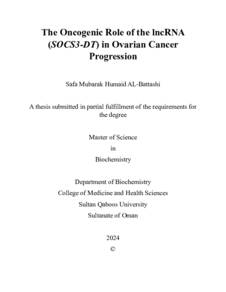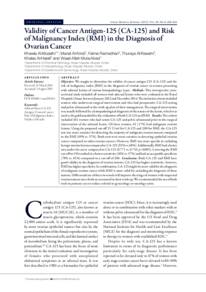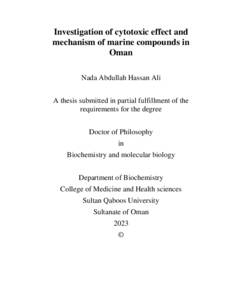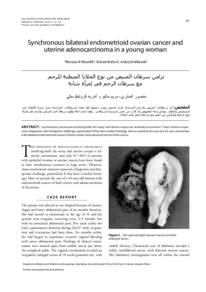Document
The oncogenic role of the lncRNA (SOCS3-DT) in ovarian cancer progression.
Source
Master's thesis
Other titles
الدور الجيني للحمض النووي الرايبوزي الطويل غير المُشفر (SOCS3-DT) في تطور سرطان المبيض.
Country
Oman
City
Muscat
Publisher
Sultan Qaboos University.
Gregorian
2024
Language
English
Subject
Thesis Type
Master's thesis
English abstract
Ovarian cancer (OC) poses a significant challenge to women's health globally, contributing to high rates of cancer-related morbidity and mortality. Most OC cases are diagnosed at advanced stages, resulting in low survival rates. Therefore, it is crucial to identify effective screening methods for early detection. The discovery of long non coding RNAs (lncRNAs) as key regulators of gene expression has opened up new avenues for investigating the molecular complexities of cancer biology. Bioinformatic analysis revealed higher expression of the lncRNA SOCS3-DT in OC recurrent samples, suggesting its potential as a biomarker. However, the precise functional role of SOCS3 DT in OC remains unclear. In this study, we used qRT-PCR to monitor the expression levels of SOCS3-DT in a panel of OC cell lines and OC tissue samples from our tissue bank at SQUH, and from Origene company. Furthermore, we silenced SOCS3-DT expression in OVSAHO cells and subsequently evaluated its impact on proliferation, colony formation, and wound healing assays. Additionally, to assess the effect of SOCS3 DT knockdown on key markers associated with cancer pathways, we performed qRT PCR and western blotting analysis. In cell lines, we observed overexpression of SOCS3 DT in the high-grade OC cell line, OVSAHO (p= 0.034). Conversely, the low-grade OC cell lines (OSE 1, MCAS, A2780 CP, A2780 S, and SKOV3) exhibited downregulated expression of SOCS3-DT compared to the normal ovarian cell line (HOSE 6-3) at the RNA level. Based on these findings, the OVSAHO cell line was selected for further functional analysis. Expression analysis using qRT-PCR revealed higher levels of SOCS3-DT in the early and late stages of OC patients compared to healthy individuals, V indicating its potential as a promising marker for OC detection. Upon silencing SOCS3 DT in OVSAHO cells, we observed reduced cell proliferation and decreased colony formation ability compared to the negative control. However, no significant difference was observed in the wound-healing ability between the silenced group and the control group. Moreover, regarding the expression of the pro-apoptotic marker, knocking down SOCS3-DT reduced the expression of CASPASE-3 at RNA and protein levels and CLEAVE CASPASE-9 at the protein level. However, the anti-apoptotic marker BCL2 expression was only downregulated at the RNA level. The expression of the autophagy markers (ATG5 and BECLIN) was reduced in siSOCS3-DT treated OVSAHO cells compared to NC at the RNA level, while the level of BECLIN only was lower at the protein level. In terms of EMT markers, the expression of the epithelial marker (CDH1) was reduced at the RNA level, while the mesenchymal markers (VIMENTIN and CDH2) were downregulated at the protein level. However, there was no significant change in the expression of CASPASE 9, BAX, CYCLIN D1, and CDH2 at the RNA levels and CDK4, CDK6, ATG5, BCL2, and CYCLIN D1 at the protein level. In conclusion, this study offers novel insight into discovering a new effective detection biomarker (SOCS3-DT) involved in the early stages of the disease, with the potential to provide a novel therapeutic target and approaches for the efficient treatment of this devastating disease. Moreover, the differential expression levels of the key cancer-associated genes highlight the involvement of SOCS3-DT in apoptosis and autophagy pathways. In addition, the variation in the expression of EMT markers suggests the role of SOCS3-DT in cancer metastasis.
Arabic abstract
مال سرطان المبيض تحديا هائلا لصحة المرأة وبعد سبنا رئيسيا للأمراض والوفيات المرتبطة بالسرطان على مستوى العالم يتم تشخيص معظم المرضى الذين يعانون من سرطان المبيض في مراحل متقدمة، مما يؤدي إلى انخفاض معدلات البقاء على قيد الحياة لذا، فإن تطوير طرق فحص فعالة للكشف المبكر عن المرض أمر بالغ الأهمية وقد فتح ظهور الحمض النووي الريبي الطويل غير المشفر (IncRNAs) كمنظم محوري للتعبير الجيني افاقا جديدة لدراسة تعقيدات السرطان الجرينية والبيولوجية أظهرت تحليلات المعلومات الحيوية أن التعبير عن IncRNA SOCS3-DTيكون أعلى في مراحل مبكرة من سرطان المبيض، مما يشير إلى إمكانية استخدامه كمؤشر حيوي ومع ذلك، لم يحدد دوره الوظيفي في سرطان المبيض بشكل واضح بعد في هذه الدراسة، قمنا بمراقبة تعبير SOCS3DT في مجموعة من خلايا سرطان المبيض وعينات أنسجة سرطان المبيض من مستشفى جامعة السلطان قابوس وشركة (Origene) باستخدام تقنية RT-PCR بالإضافة إلى ذلك، قمنا بإسكات SOCS3DT في خلايا OVSAHO و أجرينا اختبارات انتشار وتكوين مستعمرات وتضميد الجروح لدراسة دوره الوظيفي في تطور سرطان المبيض لتحليل تأثير إسكات SOCS3DT على التعبير عن العلامات الرئيسية المرتبطة بمسار السرطان تم إجراء qRT-PCR و western blotting وجدنا أن SOCS3DT كان تعبيره مفرطا في خلايا سرطان المبيض العدوانية، مثل OVSAHO (ع) - 0.034 ، بينما كان تعبيره منخفضا في خلايا سرطان المبيض في المراحل المتقدمة من المرض (SKOV3) A27802780P MCAS (OSE مقارنة بخلايا المبيض الطبيعية (6-3) HOSE) على مستوى الحمض النووي الريبي (RNA) بناء على ذلك، تم اختيار خلايا OVSAHO المزيد من التحليل الوظيفي كشف تحليل التعبير باستخدام RT-PCR عن مستويات أعلى من SOCS3-D3 في المراحل المبكرة والمتاجرة لمرضى سرطان المبيض مقارنة بالأفراد الأصحاء، مما يشير إلى دوره المحتمل كعلامة للكشف عن سرطان المبيض أدى إسكات SOCS3D في خلايا OVSAHO إلى الحفاض في تكاثر الخلايا وقدرة تكوين المستعمرات مقاربة بالتحكم السلبي (NC) ومع ذلك، لم يلاحظ اختلاف كبير في القدرة على التئام الجروح علاوة على ذلك، فقد أدى هدم SOCS3DT إلى تقليل التعبير عن العلامة المؤيدة للاستماتة، حيث انخفض التعبير عن 3-CASPASE على مستوى الحمض النووي الريبي والبروتين و 9-CLEAVE CASPASE على مستوى البروتين من ناحية أخرى، تم تنظيم التعبير عن BCL2 المضاد للموت المبرمج فقط على مستوى الحمض النووي الريبي تم تقليل التعبير عن علامات الالتهام الذاتي (ATG5) و (BECLIN في خلايا OVSAHO المعالجة بـ SOCS-DT مقارنة بالتحكم السلبي على مستوى الحمض النووي الريبي، بينما كان مستوى BECLIN أقل فقط على مستوى البروتين بالنسبة لعلامات التحول الظهاري، تم تقليل التعبير عن العلامة الظهارية (CDHI) على مستوى الحمض النووي الريبي، في حين تم تنظيم علامات اللحمة المتوسطة (CDH2) و (VIMENTIN على مستوى البروتين. ومع ذلك، لم يكن هناك تغيير كبير في التعبير عن 9 CASPASE و BAX و CYCLIN DI و CDH2 على مستويات الحمض النووي الريبي و CDK4 و CYCLIN DI BCL2 ATGS CDK6 على مستوى البروتين في الختام، تقدم هذه الدراسة رؤية جديدة لاكتشاف علامة حيوية جديدة فعالة للكشف عن سرطان المبيض -SOCS) تشارك في المراحل المبكرة من المرض، مما يوفر إمكانية تقديم هدف علاجي جديد وطرق علاج فعالة لهذا المرض المنمر بالإضافة إلى ذلك، تسلط مستويات التعبير التفاضلي للجينات الرئيسية المرتبطة بالسرطان الضوء على تورط SOCS3DT في مسارات موت الخلايا المبرمج والالتهام الذاتي. كما يشير التباين في التعبير عن علامات التحول الظهاري إلى دور SOCS3DT في انتشار ورم السرطان.
Category
Theses and Dissertations




